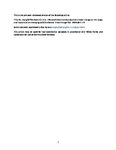Effects of historic and projected climate change on the range and impacts of an emerging wildlife disease
| dc.contributor.author | Price, SJ | |
| dc.contributor.author | Leung, WTM | |
| dc.contributor.author | Owen, CJ | |
| dc.contributor.author | Puschendorf, Robert | |
| dc.contributor.author | Sergeant, C | |
| dc.contributor.author | Cunningham, AA | |
| dc.contributor.author | Balloux, F | |
| dc.contributor.author | Garner, TWJ | |
| dc.contributor.author | Nichols, RA | |
| dc.date.accessioned | 2019-05-09T10:38:07Z | |
| dc.date.issued | 2019-08 | |
| dc.identifier.issn | 1354-1013 | |
| dc.identifier.issn | 1365-2486 | |
| dc.identifier.uri | http://hdl.handle.net/10026.1/13802 | |
| dc.description.abstract |
<jats:title>Abstract</jats:title><jats:p>The global trend of increasing environmental temperatures is often predicted to result in more severe disease epidemics. However, unambiguous evidence that temperature is a driver of epidemics is largely lacking, because it is demanding to demonstrate its role among the complex interactions between hosts, pathogens, and their shared environment. Here, we apply a three‐pronged approach to understand the effects of temperature on ranavirus epidemics in UK common frogs, combining in vitro, in vivo, and field studies. Each approach suggests that higher temperatures drive increasing severity of epidemics. In wild populations, ranavirosis incidents were more frequent and more severe at higher temperatures, and their frequency increased through a period of historic warming in the 1990s. Laboratory experiments using cell culture and whole animal models showed that higher temperature increased ranavirus propagation, disease incidence, and mortality rate. These results, combined with climate projections, predict severe ranavirosis outbreaks will occur over wider areas and an extended season, possibly affecting larval recruitment. Since ranaviruses affect a variety of ectothermic hosts (amphibians, reptiles, and fish), wider ecological damage could occur. Our three complementary lines of evidence present a clear case for direct environmental modulation of these epidemics and suggest management options to protect species from disease.</jats:p> | |
| dc.format.extent | 2648-2660 | |
| dc.format.medium | Print-Electronic | |
| dc.language | en | |
| dc.language.iso | en | |
| dc.publisher | Wiley | |
| dc.rights | Attribution-NonCommercial-NoDerivatives 4.0 International | |
| dc.rights | Attribution-NonCommercial-NoDerivatives 4.0 International | |
| dc.rights | Attribution-NonCommercial-NoDerivatives 4.0 International | |
| dc.rights | Attribution-NonCommercial-NoDerivatives 4.0 International | |
| dc.rights | Attribution-NonCommercial-NoDerivatives 4.0 International | |
| dc.rights | Attribution-NonCommercial-NoDerivatives 4.0 International | |
| dc.rights.uri | http://creativecommons.org/licenses/by-nc-nd/4.0/ | |
| dc.rights.uri | http://creativecommons.org/licenses/by-nc-nd/4.0/ | |
| dc.rights.uri | http://creativecommons.org/licenses/by-nc-nd/4.0/ | |
| dc.rights.uri | http://creativecommons.org/licenses/by-nc-nd/4.0/ | |
| dc.rights.uri | http://creativecommons.org/licenses/by-nc-nd/4.0/ | |
| dc.rights.uri | http://creativecommons.org/licenses/by-nc-nd/4.0/ | |
| dc.subject | amphibian population decline | |
| dc.subject | climate change | |
| dc.subject | common frog | |
| dc.subject | emerging infectious disease | |
| dc.subject | host-pathogen interactions | |
| dc.subject | Rana temporaria | |
| dc.subject | ranavirus | |
| dc.subject | temperature | |
| dc.subject | virulence | |
| dc.title | Effects of historic and projected climate change on the range and impacts of an emerging wildlife disease | |
| dc.type | journal-article | |
| dc.type | Journal Article | |
| dc.type | Research Support, Non-U.S. Gov't | |
| plymouth.author-url | https://www.webofscience.com/api/gateway?GWVersion=2&SrcApp=PARTNER_APP&SrcAuth=LinksAMR&KeyUT=WOS:000497502700012&DestLinkType=FullRecord&DestApp=ALL_WOS&UsrCustomerID=11bb513d99f797142bcfeffcc58ea008 | |
| plymouth.issue | 8 | |
| plymouth.volume | 25 | |
| plymouth.publication-status | Published | |
| plymouth.journal | Global Change Biology | |
| dc.identifier.doi | 10.1111/gcb.14651 | |
| plymouth.organisational-group | /Plymouth | |
| plymouth.organisational-group | /Plymouth/Faculty of Science and Engineering | |
| plymouth.organisational-group | /Plymouth/Faculty of Science and Engineering/School of Biological and Marine Sciences | |
| plymouth.organisational-group | /Plymouth/REF 2021 Researchers by UoA | |
| plymouth.organisational-group | /Plymouth/REF 2021 Researchers by UoA/UoA06 Agriculture, Veterinary and Food Science | |
| plymouth.organisational-group | /Plymouth/Users by role | |
| plymouth.organisational-group | /Plymouth/Users by role/Academics | |
| dc.publisher.place | England | |
| dcterms.dateAccepted | 2019-02-13 | |
| dc.rights.embargodate | 2020-5-8 | |
| dc.identifier.eissn | 1365-2486 | |
| dc.rights.embargoperiod | Not known | |
| rioxxterms.version | Accepted Manuscript | |
| rioxxterms.versionofrecord | 10.1111/gcb.14651 | |
| rioxxterms.licenseref.uri | http://creativecommons.org/licenses/by-nc-nd/4.0/ | |
| rioxxterms.licenseref.startdate | 2019-08 | |
| rioxxterms.type | Journal Article/Review |



